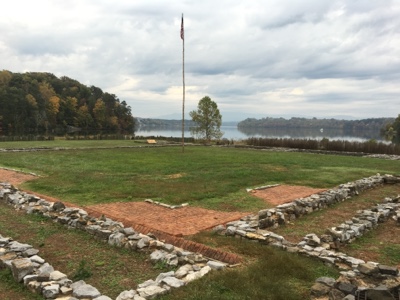
This past weekend we traveled to Vonore, a small town located at the confluence of the Little Tennessee and Tellico rivers in eastern Tennessee. My husband Tim had signed up for a 2-day Prevost Community seminar. He figured if we were purchasing a Prevost, we--or at least he!--should know more about the ins and outs of owning one.
While Tim was in class, I went searching for sights to see in
Vonore. What I found was a clash between
two cultures, European whites against the Cherokee, once a friendship, but their interactions turned
ugly during the French and Indian War.
All three sights I visited gave me insights into this discordant relationship.
Fort Loudoun, originally built in 1756 and now reconstructed, was an outpost during the French and Indian War from which the British colony of South Carolina and the Cherokee Nation stood as allies against the French. When several Cherokee chiefs were massacred at Fort Prince George in South Carolina, this alliance broke down. In retaliation, the Cherokees laid sieged to Fort Loudoun in the spring of 1760. Dwindling supplies and starvation forced the garrison to surrender in August 1760. The day following the surrender the Cherokee attacked the departing garrison at Cane Creek, killing more than two dozen. After its surrender, Fort Loudoun was never used again for any military purpose.
 |
| Fort Loudoun's Gate |
 |
| A cannon on the fort's ramparts |
 |
| The fort was built on an island in the middle of the Little Tennessee River |
 |
| Soldiers' barracks |
Sequoyah Birthplace Museum stands near the former location of a Cherokee village where Sequoyah was born circa 1776. Sequoyah developed a writing system that preserved the language of the Cherokee. The museum which belongs to the Eastern Band of the Cherokee Nation (those who managed to evade the Trail of Tears removal in 1830s), promotes a greater understanding of the history of its people.
 |
| Sequoyah Birthplace Museum |
 |
| Sequoyah |
 |
| The Seal of the Eastern Band of the Cherokee Nation |
 |
| This wooden framework shows the structure of a Cherokee council house. |
 |
| Archeology excavations in the area found the remains of 191 Cherokees. They were laid to rest in this burial mound on the grounds of the museum. |
Tellico Blockhouse from 1794 through 1807 functioned as a trading post between Americans and the Cherokee and was also a check against white encroachment. Those of European descent were required to have written passes from the Commander of the Blockhouse before entering deeper into Cherokee land. Today all one can see are the foundations of what was once a thriving trading post.
The gap between the two cultures was best seen
through quotes posted on the walls of Sequoyah’s Birthplace Museum. These quotes were from Chief Ostenaco who acted as a diplomat between
the two peoples and Lt. Henry Timberlake who published his memoirs in
1765. I wish now I’d copied several down
so I could share them here. Oh, well! That gives me a reason to return to Vonore.














Thank you Cindy for sharing and educating me a little! Your pictures are wonderful and I love being able to join you in your travels! Enjoy all the blessings!
ReplyDeleteIf only you'd been with me, Tami! What fun we could have had! Next time, Cape Cod!
ReplyDeleteWhat an amazing history in that area. When we visited the Cowboy Museum in Oklahoma this past summer they pay incredible homage to the Indians and have a beautiful statue emblematic of the "Trail of Tears"! Glad you were able to visit here.
ReplyDelete